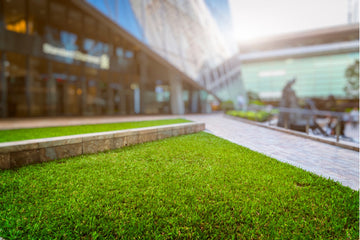If your lawn feels hard, too thatchy (excess layer of dead grass and roots), or water just isn’t sinking in, it might be time to aerate. Aeration is the process of loosening up compacted soil and breaking through thatch so oxygen, water, and nutrients can reach the roots of your grass.
Long trusted on golf courses and sports fields, aeration is just as valuable for residential lawns, especially if yours gets a lot of foot traffic.
Why Should You Care About Aeration?
Think of aeration as a reset button for tired soil. Over time, your lawn naturally becomes compacted, especially in high-traffic areas. When soil is too dense, it can’t absorb water properly. Aeration creates small openings in the lawn to reduce compaction and allow:
- Water to soak deeper into the ground
- Oxygen to reach the roots
- Nutrients to travel where they’re needed most
The result is a healthier, thicker, and more resilient lawn.
Do You Have Thatch or Compaction?
Two common barriers to lawn health are thatch and compacted soil. Thatch is a layer of organic matter (like dead grass, stems, and roots) that builds up between the soil and grass. Compaction squeezes the soil so tightly roots can’t spread or absorb water. They both prevent water, fertilizer, and air from reaching the roots.
Aeration helps with both by breaking through the thatch layer and loosening compacted ground so your lawn can breathe again.
Signs you need aeration:
- Your soil feels hard or spongy
- Water pools or runs off instead of soaking in
- Grass is thinning, yellowing, or stressed
Try the screwdriver test: if a screwdriver doesn’t easily slide into the soil, it’s time to aerate.
Solid vs. Core Aeration: Which One’s Right for You?
There are different ways to aerate a lawn. Both core and solid aeration have benefits, and the right choice depends on your soil type, lawn size, and how much traffic your yard gets.
Core Aeration (Mechanical Plugging)
Best for: Lawns with severe compaction, heavy thatch, or areas that have been neglected over time.
How it works: Pulls out small plugs of soil and thatch, leaving open channels that improve drainage, oxygen exchange, and root growth.
Where it shines: Residential lawns needing a seasonal “reset” to reduce thatch and promote stronger, deeper roots.
How often: Once a year is enough for most lawns, ideally in spring or fall.
Solid Aeration
Best for: Compact soils that restrict root growth, especially in summer, or lawns where clippings are collected regularly.
How it works: Solid metal tines punch deep holes into the soil without removing plugs. This breaks up compaction at depth, improves root penetration, and helps water soak in.
Where it shines: High-traffic areas like sports fields, playgrounds, or clay-heavy residential lawns where compaction happens quickly but downtime is limited.
How often: Use as needed in compacted or drought-prone areas to keep roots spreading and lawns resilient.
When to Aerate Your Lawn
Timing matters when it comes to aeration. Fall is the sweet spot for Ontario and Quebec lawns.
That’s when cool-season grasses like Kentucky Bluegrass are actively growing, giving your lawn time to recover, thicken up, and prepare for winter.
Avoid aerating during extreme heat or drought. Summer stress can slow down recovery and leave your grass vulnerable instead of stronger.
Pro tip: Aerate when your soil is moist but not soaked. The day after a rainfall or watering is perfect.
How to Aerate Like a Pro
1. Water 1-2 days before
Soil should be moist but not soggy, this makes the job easier and more effective.
2. Mark sprinklers and underground wires/pipes
Don’t risk damaging irrigation or utilities. Flag them ahead of time.
3. Use the right tool
Small lawn - Try aerator shoes or handheld toolsLarge lawn - Rent an aerator
4. Make two passes
Aerate in a crisscross pattern for best coverage, especially in high-traffic areas.
5. Leave the plugs
If you core-aerated, let the soil plugs dry and break down naturally. They’ll add nutrients back into the lawn.
What to Do After Aerating
Overseed bare or thinning areas
Aeration creates the perfect conditions for seed-to-soil contact and germination.
Water consistently
Lightly water every 2-3 days for a few weeks to help new roots establish. Since fall is the best time to aerate, cooler temperatures and less evaporation mean heavy watering isn't necessary.
Fertilize if needed
After aerating is a great time to apply a slow-release fertilizer.
The Gift That Keeps Giving
Aeration is an investment in your lawn’s health. By improving airflow, drainage, and root development, you’ll see:
- Stronger, deeper roots
- Thicker, greener grass
- Better water absorption
- Reduced weeds and thatch
Aerated lawns make every other lawn care task, from watering to fertilizing, more effective.
If you’d like a hand with aerating your lawn we’re always happy to help.





